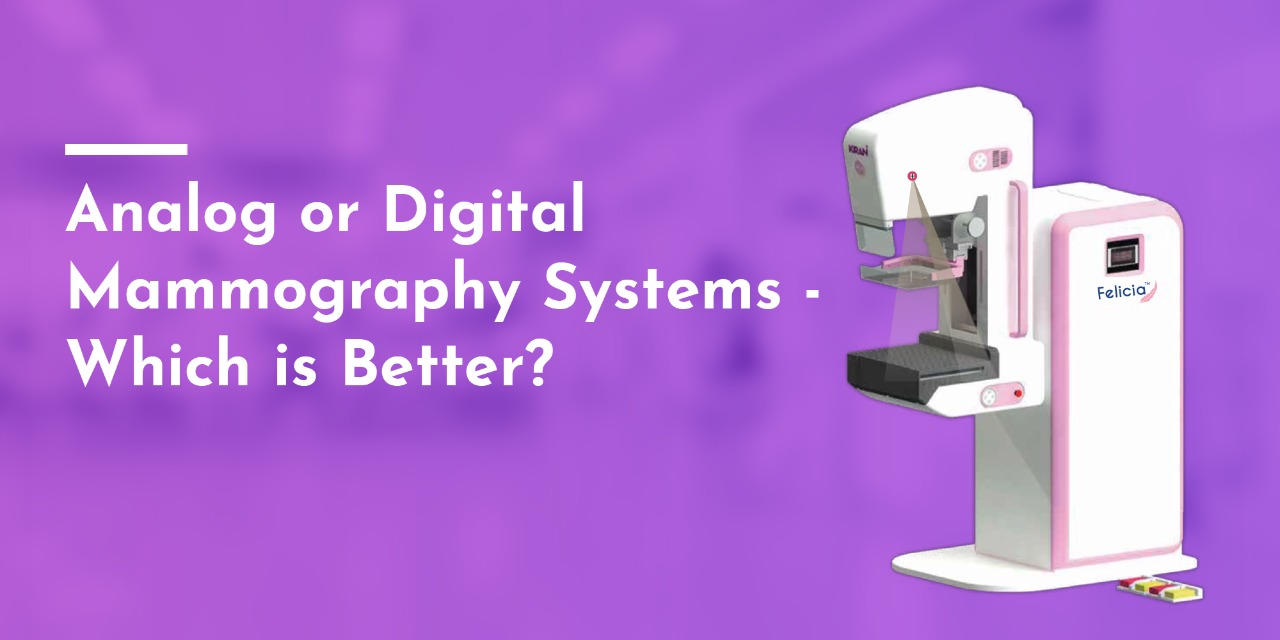Screening mammography is a test carried out for the detection of early signs of breast cancer in women when there are no visible signs and symptoms of the disease. A mammogram provides a clear X-ray image of the breast. It can be used to examine changes in the breast tissue like a lump found in the breast or other signs of breast cancer.
A technologist or expert conducts the mammography by placing the patient’s breasts on a plastic plate of Mammography machine and then pressing them from above to make them flat. The X-ray targets the breasts from all sides and provides a complete picture of them. Standard mammography involved the use of Analog (film-based) mammography machines for many years. But with some advancements, the FDA-approved digital mammography unit provides the first full-field picture of the breasts that came into existence which dramatically improved the image quality.
Comparison between Analog and Digital Mammography:
In Analog mammography, low doses of radiation producing X-rays are used to detect the changes in tissues of the breasts. Film cassettes capture the X-ray beams and generate a film that presents the breast from various angles. The doctor can examine the film or convert it into a digital image by translating it using computed radiography.
In contrast, Digital mammography catches the X-ray beams on a digital detector which converts the X-ray into electrical signals and sends it to a computer. This results in high-resolution, computerized images of the breast which can be reviewed on a special monitor. The radiologists can also analyze the digital images of the breasts by using the tools and options of a workstation or console. They can mask the light in the images, magnify them, produce a negative picture (inverted image), and then compare them with earlier mammograms.
Analog mammography is cheaper than a Digital mammography system and using computed radiography it can still provide a digital image of the breast. As there is no requirement for digital detectors, the repairing or maintenance of analog mammography machines is less expensive. It is easy to find companies providing service contracts of analog mammography (with or without Computed radiography).
Cons of Analog mammography are that the quality of the image obtained is inferior to that of digital mammography. The image is received after a while as the film used in analog mammography needs to be removed and further placed into a CR reader to get digital pictures of the breast. As the machine involves the working of two systems i.e. film-based picture and digital image, default in any one of them would make the entire process of conversion of an analog picture into digital image “down”. Archiving pictures and having communication systems are less possible. As there are very few analog mammography machines sold in the market, it becomes difficult to find repair parts for the existing analog equipment, if needed.
Pros of using Digital mammography are that it is highly efficient in the workflow as the digital images are instantly displayed on the computer monitor. Thus it requires fewer retakes and allows easy repositioning of the patients, if necessary.
The images are very clear with no limitation on the size of the breasts. Crisp images of even enlarged breasts can be achieved. The diagnosis of the breast condition is easier as the images are transferred electronically to the central location using PACS (Picture Archiving and Communication System). It can be better analyzed, manipulated for better views, and handled. The dose of radiation used for X-ray production is 30 to 40% lower than the analog systems, thereby making it safe. A doctor can detect early breast cancer (even of highly dense breasts) with a digital mammography machine rather than analog mammography. The digital system makes use of computer-aided detection (CAD) devices that provide optimal images.
The drawback of digital mammography is that it is a little expensive. However, this is a minor concern because of the advantages offered by it.
Trivitron Felicia Digital Mammography System:
Trivitron Healthcare is at the forefront of innovation in Medical Imaging using Digital Technology, having launched Digital Radiography, Digital C-Arms and now being the leader in Digital Mammography.
Take breast cancer research to next level through power technology with Trivitron Felicia Digital Mammography System. Felicia is a Reliable and superior mammography solution that enables healthcare providers to deliver high-quality patient care with the highest diagnostic confidence. The device is designed in such a way as to obtain high-quality clinical images at a very low radiation dose.
Trivitron Felicia Digital Mammography System comes with a world-class X-Ray Source that emits a Biangular X-Ray tube that provides significantly higher mA loading and output while maintaining focal spot results in exceptionally high quality, high-resolution images for both full field and magnification view. Rhenium Tungsten target X-Ray tube with rhodium and silver filter reduces radiation dose to the patient without compromising the image quality. All mammography studies are scaled automatically and aligned to ensure optimal side-by-side comparison.
While deciding which type of mammography machine to opt for, it’s important that an individual considers all the advantages and disadvantages of the two mammographies and choose according to his/her needs.
After making a comparison, it has been found that digital mammography outweighs analog mammography in many things. The only takeaway is that one must aim for digital mammography if one has a decent budget.

